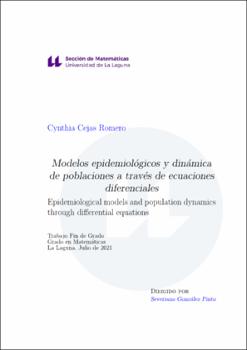Modelos epidemiológicos y dinámica de poblaciones a través de ecuaciones diferenciales
Autor
Cejas Romero, CynthiaFecha
2021Resumen
La modelizaci´on matem´atica de las epidemias despert´o gran inter´es
a principios del siglo XX en la comunidad cient´ıfica, pues epidemias
como la viruela o el sarampi´on arrasaron con la vida de miles de
personas en los siglos XVIII, XIX y XX. A d´ıa de hoy, el estudio de
las enfermedades infecciosas sigue estando de actualidad, sobre todo
en estos tiempos en que estamos sufriendo una pandemia v´ırica por
COVID-19. En la epidemiolog´ıa, las matem´aticas juegan un papel
importante pues permiten el desarrollo de modelos que simulan la
evoluci´on y propagaci´on de las enfermedades infecciosas. A lo largo
del presente trabajo se estudiar´an diversos modelos epidemiol´ogicos
a trav´es de ecuaciones diferenciales ordinarias. En particular, nos
centraremos en el modelo SIR y algunas de sus variantes para predecir la propagaci´on de enfermedades epid´emicas y end´emicas, todo
ello gracias al estudio de los estados estacionarios y la estabilidad de
cada uno de los modelos. Adem´as, comprobaremos que las medidas
de erradicaci´on y control, en concreto la vacunaci´on, son claves para
frenar la transmisi´on de enfermedades infecciosas. En este estudio
tambi´en simularemos la evoluci´on de la COVID-19, prediciendo de
manera aproximada las posibles olas de la enfermedad.
Cabe destacar que tambi´en se realiza una introducci´on a la din´amica de poblaciones pues, como veremos, puede ser ´util a la hora de
analizar modelos epidemiol´ogicos. The mathematical modelling of epidemics aroused great interest in
the scientific community at the beginning of the 20th century, as
epidemics such as smallpox or measles devastated the lives of thousands of people in the 18th, 19th and 20th centuries. Today, the
study of infectious diseases continues to be topical, especially in these times when we are suffering a viral pandemic due to COVID-19.
In epidemiology, mathematics plays an important role as it allows
the development of models that simulate the evolution and spread
of infectious diseases. Throughout this work, various epidemiological
models will be studied through ordinary differential equations. In particular, we will focus on the SIR model and some of its variants to
predict the spread of epidemic and endemic diseases, all this thanks
to the study of the stationary states and the stability of each of the
models. In addition, we will see that eradication and control measures, in particular vaccination, are key to curbing the transmission of
infectious diseases. In this study we will also simulate the evolution
of COVID-19, predicting roughly the possible waves of the disease.
It should be noted that there is also an introduction to the dynamics
of populations because, as we will see, it can be useful when analyzing
epidemiological models.





